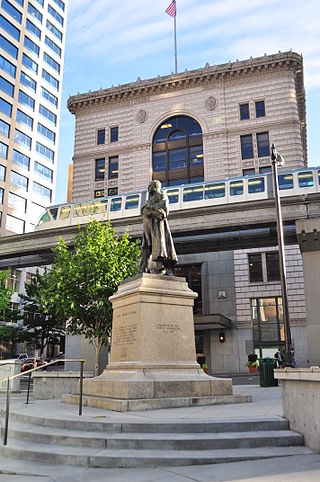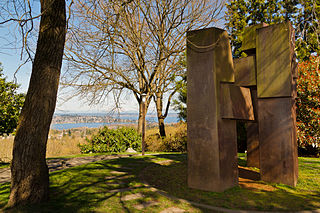
Richard Henry Park was an American sculptor who worked in marble and bronze. He was commissioned to do work by the wealthy of the nineteenth century. He did a marble bust of John Plankinton, an astute businessman who founded the meat industry in Wisconsin and was "Milwaukee's foremost citizen."

The Quest, sometimes referred to as Saturday Night at the Y or Three Groins in a Fountain, is an outdoor marble sculpture and fountain designed by Count Alexander von Svoboda, located in Portland, Oregon in the United States. The sculpture, carved in Italy from a single 200-ton block of white Pentelic marble quarried in Greece, was commissioned by Georgia-Pacific in 1967 and installed in front of the Standard Insurance Center in 1970. It depicts five nude figures, including three females, one male and one child. According to the artist, the subjects represent man's eternal search for brotherhood and enlightenment.

Theodore Roosevelt, Rough Rider is a bronze sculpture by American artist Alexander Phimister Proctor, formerly located in the South Park Blocks of Portland, Oregon in the United States. The equestrian statue was completed in 1922 and depicts Theodore Roosevelt as the leader of the cavalry regiment that fought during the Spanish–American War called the Rough Riders. It was toppled by demonstrators during the Indigenous Peoples Day of Rage in October 2020 and has not been restored.

Sacajawea and Jean-Baptiste is a bronze sculpture of Sacagawea and Jean Baptiste Charbonneau by American artist Alice Cooper, located in Washington Park in Portland, Oregon, in the United States.

Pioneer Woman, also known as Joy, Joy (Pioneer Woman), the Laberee Memorial Fountain, Mother/Child and Young Pioneer Woman, is an outdoor 1956 bronze sculpture and drinking fountain by American artist Frederic Littman, located at Council Crest Park in Portland, Oregon.

River Legend is an outdoor 1976 basalt sculpture by American artist Dimitri Hadzi, located outside of the Edith Green – Wendell Wyatt Federal Building in Portland, Oregon.

Over the Top to Victory, also known as Doughboy Statue and Their Country's Call Answered, is an outdoor bronze sculpture by John Paulding, formerly located at the Marion County Courthouse in Salem, Oregon, United States. The statue was commissioned by the American War Mothers and the Gold Star Mothers Club to commemorate the 87 men and one woman from Marion County who died in World War I.

Thomas Jefferson is a 1911 bronze statue of a seated Thomas Jefferson created by Karl Bitter for the Cuyahoga County Courthouse in Cleveland, Ohio, United States.

McGraw Square is a small plaza and streetcar stop in the Denny Triangle neighborhood of Seattle, Washington. The 0.01-acre (0.0040 ha) park, one of the smallest in the city park system, is named for and features a statue of former King County Sheriff and Governor of Washington John Harte McGraw. McGraw Square is bounded to the north by Stewart Street, to the west by 5th Avenue and the Times Square Building, and to the east by Olive Way and the Medical Dental Building.

Australian Seal is an outdoor sculpture of 1968–69 by Thomas Bass, installed outside the Embassy of Australia, Washington, D.C., in the United States. The bronze sculpture measures approximately 8 feet (2.4 m) x 5 feet (1.5 m) x 2 feet (0.61 m) and is set on a flagstone base. It depicts a kangaroo, emu, and the Australian shield, which includes images of St. George's Cross, Queen Victoria's crown, a Maltese Cross, magpie, black swan, and lions. Above the shield is a seven-pointed star.
The Quest is an outdoor 1983 sculpture of Alice Biddle by Kirk St. Maur, installed on the Oregon State University campus in Corvallis, Oregon, in the United States.

Untitled is an outdoor 1975 sculpture by Lee Kelly, installed at Louisa Boren Park in Seattle, Washington, in the United States. The abstract, welded Cor-Ten steel piece measures approximately 19 feet (5.8 m) x 14 feet (4.3 m) x 10 feet (3.0 m).

Wind Cradle is an outdoor 1976 stainless steel sculpture by Ali Baudoin, installed at the Seattle Central College campus in Seattle, Washington, in the United States.

The Falconer is a bronze sculpture by James Lee Hansen. Dates for the abstract piece range from the 1960s to 1973.
Sasquatch Pushing Over a House is an outdoor 1982 sculpture by Richard Beyer, installed Seattle's University Playground, in the U.S. state of Washington.

John Harte McGraw is an outdoor 1912 bronze sculpture depicting the former governor of the same name by Richard E. Brooks, installed in McGraw Square at the intersection of Fifth Avenue and Olive Street in Seattle, in the U.S. state of Washington.

Three Piece Sculpture: Vertebrae is an abstract bronze sculpture by Henry Moore.

Oregon Landscape is a 1962 bronze sculpture by Tom Hardy, installed on the southern exterior wall of the Science Research and Teaching Center, on the Portland State University campus in Portland, Oregon, United States. Previously, the artwork was installed on Fariborz Maseeh Hall's western facade.

George Washington is an outdoor equestrian statue by the Scottish-American sculptor J. Massey Rhind located in Washington Park in Newark, New Jersey. It depicts General George Washington saying farewell to the troops of the Continental Army on November 2, 1783, and was dedicated on the anniversary of that event in 1912.

George Washington is an outdoor equestrian statue by the American sculptor Frederick Roth located near the Ford Mansion, Washington's Headquarters, in Morristown, New Jersey, United States. It was commissioned by philanthropist E. Mabel Clark to commemorate General George Washington's importance to the history of the city. The bronze sculpture was dedicated on October 19, 1928, the anniversary of the surrender of British General Charles Cornwallis at Yorktown in 1781.




















